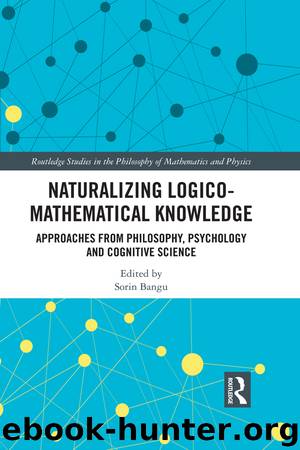Naturalizing Logico-Mathematical Knowledge by Sorin Bangu

Author:Sorin Bangu
Language: eng
Format: epub
Publisher: Taylor & Francis (CAM)
6. Fine-Grained Numerical Affordances
The capacity to perceive number is independent of and developmentally more basic than the capacity to pick up macroscopic objects and arrange them into spatially bounded collections. However, this need not be seen as fatal for understanding numerical perception in terms of affordances. The problems with Kitcher’s account arise as a result of taking a far too coarse-grained form of action to be relevant for perceiving numerical affordances.
Elucidations of ecological psychology tend to focus on affordances for relatively coarse-grained, deliberative actions, such as graspability or climbability. However, this should not be seen as a reflection of the details of the theory. Rather, these are simply affordances that are easier (although still somewhat cumbersome) to articulate. Yet this should not obscure the fact that most of the affordances we perceive will be more fine-grained, not necessarily associated with any conscious deliberation, and much harder to articulate, lacking any corresponding action verb. For example, one can perceive affordances for adjusting one’s bodily position in a specific manner so as to fit through a gap, or for adjusting the position of one’s eyes in a particular way so as to bring a different region of space into view.
The question thus arises as to which more fine-grained form of action is relevant for numerical perception, in the sense of being a common feature of all enumerative actions. A prime candidate for this role is sequential attention. Counting the objects in a collection requires attending to each object in sequence.2 Importantly, this is not only the case for collections of macroscopic objects but also applies to non-manipulable collections, including collections of nonvisual stimuli such as beeps or touches. Moreover, unlike object manipulation, the capacity for sequential attention is something that we share with young infants and a wide range of other species. Kitcher was correct to focus on the collective activity of manipulating objects, not because this is the basis of our capacity for numerical perception, but because all instances of this behavior involve the more fundamental action of sequential attention. Whenever we perceive an affordance for bringing objects together into a collection, we perceive an affordance for sequentially attending to each object, but not vice versa.
Importantly, as with collective activity, the type of attention sequence one carries out in sequentially attending to the items in a three-membered collection will differ significantly from that which will be involved in doing so with a four- or five-membered collection (and so on), and, as such, each number will be associated with a specific type of attention sequence whose affordance can be directly perceived. We perceive numbers by perceiving affordances for enumerative action, where enumerative action is understood in terms of sequential attention. We see numbers by seeing that we can count.
The idea that numerical perception is closely associated with our capacity for sequential attention is supported by neurological evidence. The intraparietal sulcus, the area in which the ANS is held to be located, is a system that is widely held to be involved in
Download
This site does not store any files on its server. We only index and link to content provided by other sites. Please contact the content providers to delete copyright contents if any and email us, we'll remove relevant links or contents immediately.
| Anthropology | Archaeology |
| Philosophy | Politics & Government |
| Social Sciences | Sociology |
| Women's Studies |
The remains of the day by Kazuo Ishiguro(8351)
Tools of Titans by Timothy Ferriss(7763)
Giovanni's Room by James Baldwin(6774)
The Black Swan by Nassim Nicholas Taleb(6733)
Inner Engineering: A Yogi's Guide to Joy by Sadhguru(6421)
The Way of Zen by Alan W. Watts(6266)
Asking the Right Questions: A Guide to Critical Thinking by M. Neil Browne & Stuart M. Keeley(5335)
The Power of Now: A Guide to Spiritual Enlightenment by Eckhart Tolle(5308)
The Six Wives Of Henry VIII (WOMEN IN HISTORY) by Fraser Antonia(5209)
Astrophysics for People in a Hurry by Neil DeGrasse Tyson(4987)
12 Rules for Life by Jordan B. Peterson(4152)
Housekeeping by Marilynne Robinson(4039)
The Ethical Slut by Janet W. Hardy(4020)
Skin in the Game by Nassim Nicholas Taleb(3954)
Double Down (Diary of a Wimpy Kid Book 11) by Jeff Kinney(3895)
Ikigai by Héctor García & Francesc Miralles(3849)
The Art of Happiness by The Dalai Lama(3831)
Skin in the Game: Hidden Asymmetries in Daily Life by Nassim Nicholas Taleb(3711)
Walking by Henry David Thoreau(3669)
